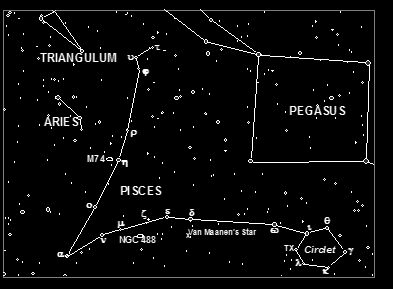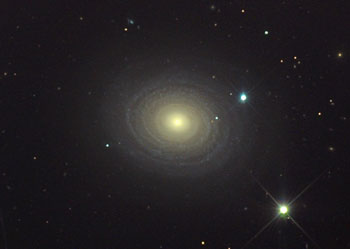Pisces and Piscis Austrinus
Pisces is a very faint constellation, possessing no star brighter than the fourth magnitude. However, owning to its position on the Zodiac it is both ancient and well known. Aries is usually considered the first sign of the Zodiac but in fact it should be Pisces because even by the time of Christ the First Point of Aries (the point at which the Sun crosses the celestial equator travelling North, marking the start of Spring in the Northern Hemisphere) had already moved from Aries into Pisces due to the effect of precession. Pisces unfortunately does not make up for the faintness of its stars with an array of interesting deep sky objects for telescopic observers.
Pisces does have a couple of fine double stars, the best of which is Zeta Piscium. Zeta Piscium consists of a fourth magnitude white and fifth magnitude yellow pair with nice contrast and an easy separation of 23 arcseconds. Alpha Piscium also consists of a fourth and fifth magnitude duo, although the separation of around one arcsecond is likely to be rather more challenging.

NGC488 (Credits:Tony Kriz/Adam Block/NOAO/AURA/NSF)
There are a number of curious, as opposed to spectacular objects in Pisces. For instance, at 14 light years, 12th magnitude Van Maanen’s star, close to Delta Piscium, is one of the closest white dwarfs to Earth, apart from the well known faint companions of Sirius and Procyon. Another interesting object is the very red star TX Piscium in the grouping known as “The Circlet”. At sixth magnitude, this distant red giant is one of the brightest stars belonging to the rare spectral type “N”. N type stars are even cooler than normal “M” type red giants (i.e. less than 3,000oK) and are also known as “Carbon” stars because of the existence of complex Carbon compounds in their atmospheres.
Piscis Austrinus, some way to the South West of Pisces is one of the most southerly constellations visible from the UK. Its only really notable object is its brightest star Fomalhaut. This star is a very ordinary main sequence star although it is 17 times more luminous than our own Sun. It is estimated that Fomalhaut is a very youthful 100 million years old, compared with our middle-aged 4.6 billion year old Sun and the really interesting thing about it is that infra-red studies have shown the existence of a ring of gas and dust surrounding the star which is very likely to be a planetary system in the making.